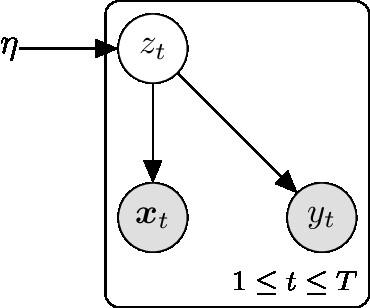The dataset is $\{\boldsymbol x_t,y_t\}$ for $t=1,\dots,T$, where $y_t \in \{0,1\}$. Define a generative latent variable classifier whose plate diagram is shown above. For each data point, a local latent $z_t$ is associated, whose prior is parameterized by the hyperparameter $\eta$. The conditional probabilities $p(\boldsymbol x_t \mid z_t)$ and $p(y_t \mid z_t)$ are parameterized by fixed model parameters $\boldsymbol\theta$. The posterior $p(z_t \mid \boldsymbol x_t,y_t)$ is intractable due to an intractable evidence.
Fitting the model is straightforward, using variational EM. What have bugged me for a long time is how to make prediction on new data, i.e. finding the probability $p(y \mid \boldsymbol x,\boldsymbol\theta, \eta)$. Since $p(y \mid \boldsymbol x,\boldsymbol\theta,\alpha) \propto p(y,\boldsymbol x \mid \boldsymbol\theta,\eta)$, we need only to evaluate the latter form, i.e. the evidence. However, as mentioned above, the evidence is intractable:
$$ p(y,\boldsymbol x \mid \boldsymbol\theta,\eta) = \int p(z \mid \eta) p(y,\boldsymbol x \mid z,\boldsymbol\theta)\,\mathrm d z $$
where $z$ resides in some high dimensional space (Euclidean space with some constraints).
My attempts:
- I tried naive Monte Carlo. I sample from $p(z \mid \eta)$, which is easy, and estimate the average of $p(y,\boldsymbol x \mid z,\boldsymbol\theta)$. This fails of course.
- I tried importance sampling. The importance distribution is set to $q(z)$, where $q(z) \approx p(z \mid y,\boldsymbol x,\boldsymbol\theta,\eta)$ is found by variational inference (e.g., mean-field approximation). If $q(z)$ perfectly matches the posterior, there should be zero variance. Sampling from $q(z)$ is easy. Then I find the average $p(z \mid \eta)/q(z) p(y,\boldsymbol x \mid z,\boldsymbol\theta)$. Surprisingly, it seems that sampling for 100k times still does not yield good estimation for the evidence, since I cannot effectively discriminate between $\log p(y=0,\boldsymbol x \mid \boldsymbol\theta,\eta)$ and $\log p(y=1,\boldsymbol x \mid \boldsymbol\theta,\eta)$.
- I know Metropolis-Hastings algorithm, which could be easier to work with in high dimension (Murphy, 2012). But I can't figure out how to apply it to my problem, since sampling from $p(z \mid \eta)$ is already an easy problem.
- I make prediction directly using the Evidence Lower Bound (ELBO), which fails because it's too biased and is not discriminative enough.
I also find this problem kind of related to marginal likelihood estimation in VAE, if dropping the $y_t$ variable. In (Kingma & Welling, 2014), the authors claim that the marginal likelihood can be found only in low-dimensional setting.
My question: Is there a general guideline on how to make prediction with such generative latent variable classifier? I feel this should be an easy problem... or maybe I'm not on the right track -- should try something other than finding the marginal likelihood to make prediction?
Thank you so much for any help and suggestions!
EDIT:
I'd like to draw connection with latent factor regression (a.k.a. supervised PCA) (Murphy, 2012; chapter 12.5.1) to make this problem a bit more concrete. In latent factor regression, the (conditional) probabilities are all Gaussians: $p(z_t) = \mathcal N(\mathbf 0, \mathbf I)$, $p(y_t \mid z_t) = \mathcal N(\mathbf w_y^\top z_t + \mu_y, \sigma_y^2)$, $p(\boldsymbol x_t \mid z_t) = \mathcal N(\mathbf W_x z_t + \boldsymbol\mu_x, \sigma_x^2 \mathbf I)$. To convert to the model in this question, simply replace the Gaussian in $p(y_t \mid z_t)$ with a Bernoulli, e.g. $p(y_t \mid z_t) = \mathrm{Ber}(\mathrm{sigmoid}(\mathbf w_y^\top z_t + \mu_y))$.

